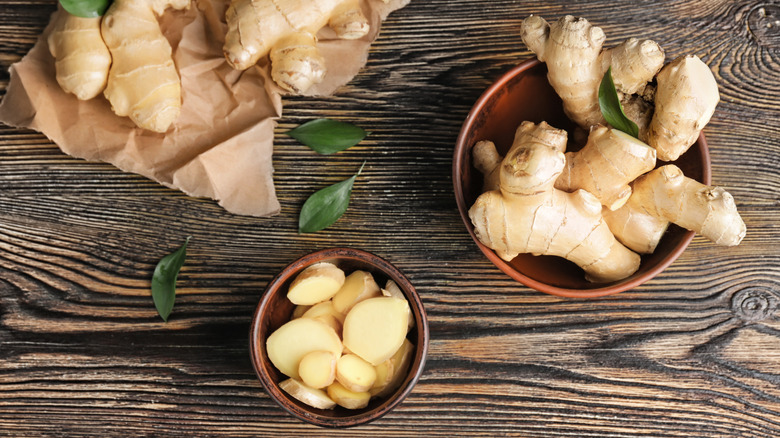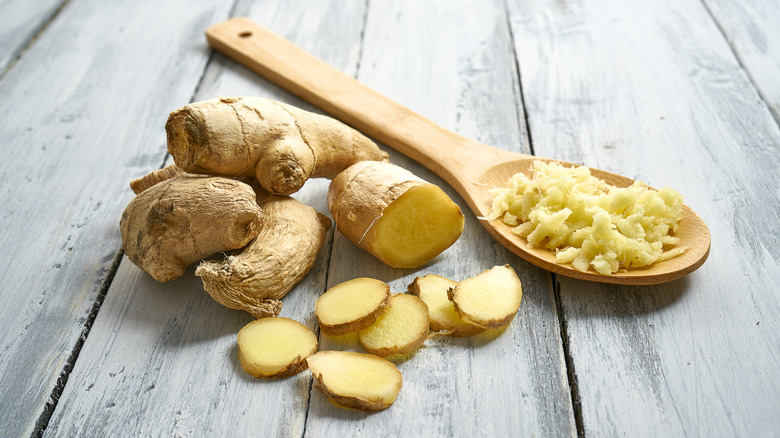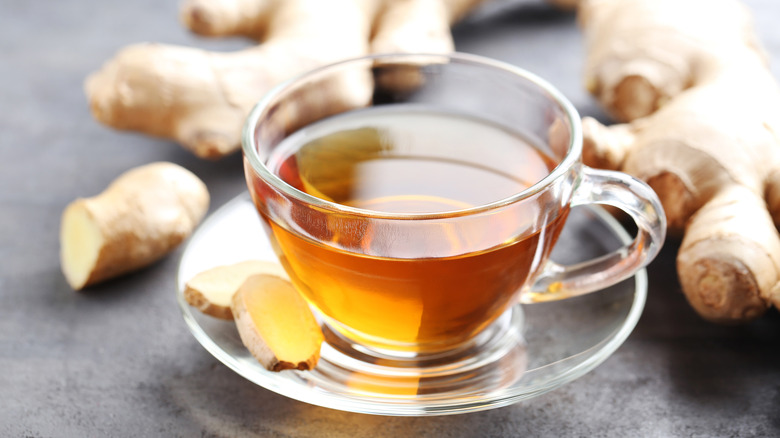Plot Twist — You Don't Actually Have To Peel Ginger
Peeling fresh ginger can be a finicky and tedious task. Most recipes that use ginger call for carefully chipping away at the irregularly-shaped root with knives, vegetable peelers, or a spoon before you use it. One of the biggest mistakes you can make with ginger is accidentally cutting off and wasting bits of it when trying to peel it, or even getting overzealous in the process and landing yourself with a knife injury. Luckily, for those of us who truly dread this kitchen chore, it turns out that you can leave the skin on your ginger for most recipes, with no ill effects on your food.
Ginger skin is usually very thin, so unless you're using whole chunks or large slices of the root in a recipe where they won't be broken down, you don't have to do any peeling. Rather than fussing over how you'll take the skin off your ginger, try just washing the outside with water and proceeding with your recipe. A quick rinse should remove any dirt or residue on its surface, making the skin safe to consume. Feel free to just mince or grate the root from there. When grated, the skin will simply dissolve, and with mincing, the skin is so thin that it won't be noticeable in the finished dish. Plus, ginger skin does not taste any different from its flesh, so it can be seamlessly incorporated into salad dressings, curries, or even some homemade ginger ale.
Ginger peel contains vital nutrients
Saving time and effort isn't the only good reason to skip out on peeling ginger. Studies have linked 6-gingerol, the most populous compound in ginger root, with antioxidant, anti-inflammatory, and anti-cancer properties. Ginger peels not only contain this compound, but are also full of phytochemicals (natural compounds found in plants) that have even more antioxidant effects. Extra nutrition is another great case for incorporating ginger peels into your recipes when you can.
If you do have to peel ginger for a recipe, and now you have peels laying around your kitchen, try freezing the scraps and using them as an aromatic. This is a no-waste trick that can help you out whenever you want a boost of fresh, spicy, and sweet flavors in your food. Just throw the peels into meat marinades or other flavorful liquids, and fish them out once they've given up their flavor and nutrients to the mixture. You'll not only give more flavor to your food, but you'll be fortifying your meals with more antioxidants.
Turn your ginger peels into stock or tea as well
Uses for ginger peels don't stop at marinades. These leftovers can also be used to create a flavor-packed ginger broth.To create this broth, just add your ginger peels to some boiling water. The more peels you use, and the less water you boil them in, the stronger the stock will be. Simmer for about half an hour and then strain out the peels. The broth can be stored in the fridge as a convenient source of flavor. The liquid will be infused with the signature sweet and spicy kick found in ginger, as well as plenty of nutrients.
Chili, mixed drinks, and smoothies are just a few recipes that would benefit from a splash of ginger stock, and you can even use the broth to steam food and infuse it with a hint of ginger. You can also add honey and drink the stock alone as a soothing ginger tea, though you may want to boil the peels for a shorter time for a subtler flavor. If you find yourself really enjoying the stock, save the peels you used make it and boil them again to create another batch. There's so much good flavor in the peels that you can definitely get away with reusing them. The second batch of broth won't be as knock-your-socks-off spicy, but it will still be tasty and economical.



